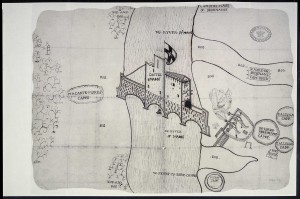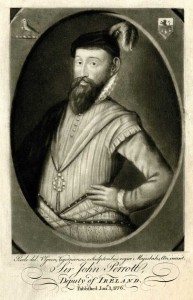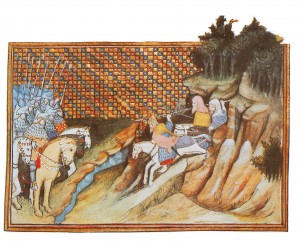‘Wild Irishmen’: cartographic evidence from the siege of Castle Maine, 1572
Published in Early Modern History (1500–1700), Features, Issue 3 (May/June 2015), Volume 23
The map of the siege of Castle Maine, probably drawn shortly after Sir John Perrot’s victory in August 1572. (UK National Archives, Kew)
The map of the siege of Castle Maine was probably drawn shortly after the victory of Munster president Sir John Perrot in August 1572, since it was entered into the state papers in December of that year. The map acknowledges the attacking crown force through a depiction of their camps, their ordnance, their journey across the land and their flag, raised in victory above the castle. The map also telescopes the events of the battle, as cannon still fire at the castle’s walls despite the presence of that large, out-of-scale English flag that flies victoriously over it, signifying that the battle has already been won.
Ethnic distinctions

Sir John Perrot, who became the first president of Munster in 1570–1, was tasked with suppressing the Desmond rebellion. (British Library)
The depiction of Perrot’s army is unique amongst late sixteenth-century Irish battle maps because it recognises the distinct ethnicities within his forces. The cartographer drew the Scottish galloglass and the Gaelic Irish in their own companies, spatially separated from Perrot’s English force. In reference to the siege, the Annals of the Four Masters states that ‘in this [Perrot’s] encampment were the muster of all the race of Eoghan-Mór [Mac Carthy], also Mac Maurice of Kerry … also the Barrys and the Roches’. The map, however, does not show MacCarthy Mór’s forces within Perrot’s encampment but rather on the opposite side of the river (though the map does note a ferry crossing that would have allowed for movement between camps), and the highly Gaelicised Old English families of MacMaurice, Barry and Roche are not depicted at all. It is possible that the cartographer did not consider the Old English and the New English culturally different, and so felt that there was no need to depict them separately. Alternatively, it may have been that the Old English forces were absorbed into the larger English army for strategic reasons; perhaps they were smaller than Mac Carthy Mór’s and the galloglass forces and thus necessarily joined Perrot’s force. Contemporary literature and treatises, however, had already begun to speak of the ‘degeneration’ or Gaelicisation of the Old English, and it is therefore also possible that the cartographer elided the Old English forces amongst the Irish force on the south side of the river.
Human activity marks the land occupied by Perrot and his troops—the traversing of the ordnance, the siege weapons and trench, and the gallows and abbey are each represented, signalling settlement and order. Furthermore, the land is cleared of all save one tree, and the bog land is almost completely marked and separated from usable land. In contrast, wilderness envelops the land occupied by MacCarthy Mór’s troops, and the cartographer drew the Irish camp without ordnance. It is possible that the Irish force did not have access to their own artillery and that Perrot did not place any heavy guns in their care. Ordnance, however, is crucial to the success of siege warfare and thus it is difficult to imagine how MacCarthy Mór’s force could have been militarily valuable without it, though it is possible that he was only responsible for ensuring that the ward did not escape into his land, explaining the lack of ordnance on the south side of the river. A difference in fighting style certainly existed between the Irish and the English, the former often successfully fighting from within bogs and woods and not engaging in open battle, although it is unlikely that such a tactic would have been effective in siege warfare.
Gerald of Wales
Whether accurate or not in this specific instance, the depiction of the Irish forces amongst forest and bog reinforces the centuries-old perception of the Irish as barbaric and uncivilised by associating them with a wild, disordered landscape. Gerald of Wales famously wrote in the twelfth century:
‘They are a wild and inhospitable people. They live on beasts only and live like beasts. They have not progressed at all from the primitive habits of pastoral living. While man usually progresses from the woods to the fields, and from the fields to settlements and communities of citizens, this people despises work on the land, has little use for the money-making of towns, condemns the rights and privileges of citizenship, and desires neither to abandon, nor lose respect for, the life which it has been accustomed to lead in the woods and countryside.’
Gerald of Wales’s writings permeated both New English and Old English commentaries and treatises on the Irish in the sixteenth century. By portraying the Irish in the wilderness without any further markers of their agency within the siege, the cartographer replicated this common literary conception of the Irish as uncivilised and wild.
The cartographer marked the presence of Irish, New English and galloglass forces on the map, but did not give any indication of the presence of the rebellious ward within the castle. The castle had been in the possession of the Desmond family since its construction, and it is likely that Old Englishmen made up at least some of the castle ward, as it was continually used in defending Desmond land from the MacCarthy Mór. James Fitzmaurice did solicit galloglass aid throughout his rebellion, though whether or not galloglass were present within the ward of Castle Maine is unknown. Neither the map nor the surviving primary sources give any clues as to who comprised the ward.
Rebel ordnance?

The forces of Art Mac Murchada sally forth from ‘wild’ mountain landscape to engage the ‘disciplined’ ranks of the earl of Gloucester, an earlier stereotypical image of the clash of two cultures as depicted by Jean Creton, a Frenchman who accompanied Richard II’s expedition to Ireland in 1399. (British Library)
Just as the cartographer did not draw rebels, neither did he draw rebel ordnance. The Annals of the Four Masters state that the rebels surrendered ‘through the want of provisions, not at all for want of defence’. While this defence could simply refer to the strength of the castle walls, it is possible that it also refers to the rebels’ own ordnance. In a letter to the queen’s treasurer, Lord Burghley, on 15 August 1572, three months after the beginning of the siege, Lord Deputy Fitzwilliam wrote that he could ‘get no answer from the President [of Munster], still occupied in the siege of Castlemang’. The length of the siege and the lack of communication coming from Perrot’s camp could indicate an armed defence of the castle; this would mean that the portrayal of the siege on the map is inaccurate and may signal that the cartographer wanted to show the rebels as a weak or unthreatening military force.
Because so little documentary evidence exists regarding the siege itself, it is difficult to verify the accuracy of its cartographic depiction. The absence of the persons and possible ordnance of the rebel force does, however, suggest that this map was not a document intended to help plan future military strategy, in which case an accurate depiction of the rebel force’s presence and weapons would have been vital. The largely out-of-scale English flag suggests that the map could have been intended to celebrate and commemorate the English victory at Castle Maine, but even this purpose is undermined by the lack of defenders, as there is nothing particularly impressive about winning an undefended castle. Because he did not depict the Old English-led rebel force or any Old English presence within Perrot’s force, and because he did not depict the Irish force with any visible weapons, the cartographer produced a picture of Munster that negated the military agency of its native and long-settled inhabitants. This suggests an intentional decision to depict these forces as militarily non-threatening, possibly owing to a desire to portray the ease with which a Tudor reconquest could be accomplished.
Megan Proper recently graduated with an MPhil in medieval history at Trinity College, Dublin.
Read More:Background
Further reading
J.H. Andrews, ‘Colonial cartography in a European setting: the case of Tudor Ireland’, in D. Woodward (ed.), The history of cartography, vol. 3 (Chicago, 2007), 1670–83.
J. Carmody, ‘The siege of Castle Magne’, Kerry Archaeological Magazine 1 (1) (October 1908).
G.A. Hayes-McCoy, Ulster and other Irish maps c. 1600 (Dublin, 1964).
G.A. Hayes-McCoy, Irish battles: a military history of Ireland (Belfast, 1969).
















